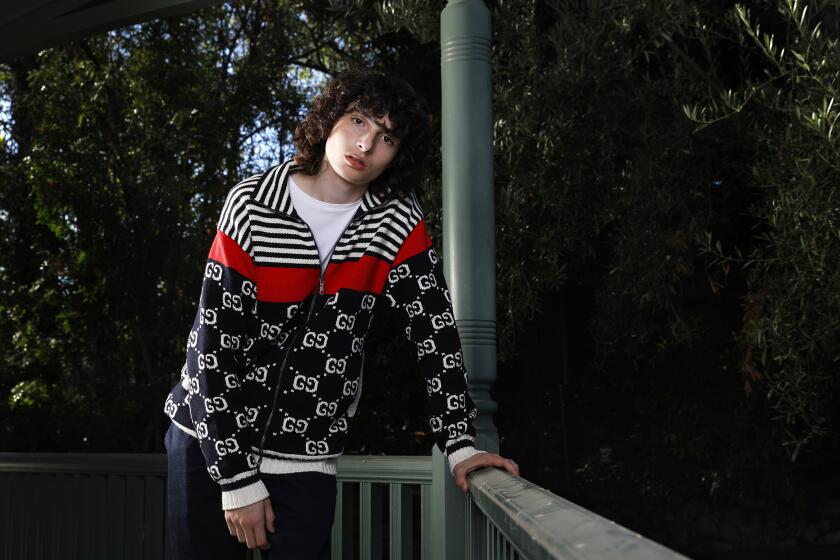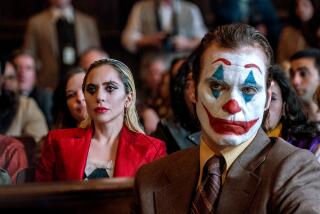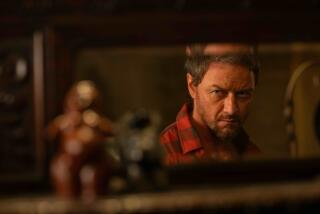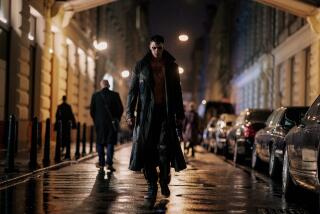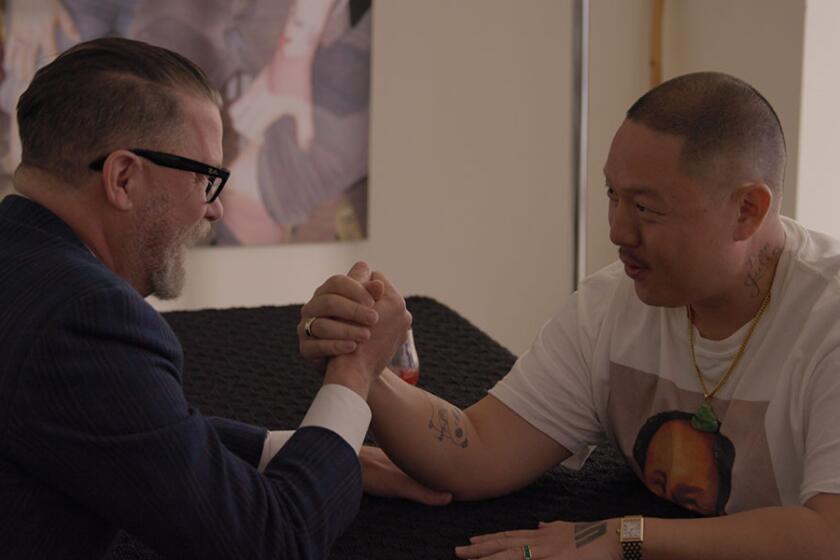Review: Overlong ‘It Chapter Two’ confronts scarier evils than Pennywise the clown
There are things far more horrific than evil, shape-shifting sewer clowns in “It Chapter Two,” the bruising conclusion to the 2017 Warner Bros. hit that brings the now-adult heroes home to face their ultimate fears.
That ancient, festering evil still lurks in Derry, Maine, where seven misfit friends dubbed the “Losers Club” were terrorized as kids one summer by Pennywise the Clown, the monstrous Stephen King creation who’s fueled nightmares since the 1986 publication of “It” and the 1990 miniseries of the same name.
Pennywise returns with new tricks, sharper teeth and a hankering for revenge in the sequel opening Sept. 6 and directed again by Andy Muschietti (“Mama”) from a script by Gary Dauberman that attempts more plot than it can handle. Still, it’s the internalized and human terrors that pack the most stomach-churning frights in “It Chapter Two.”
After focusing the first film on its 13-year-old heroes circa 1989, “It Chapter Two” adopts the mournful perspective of wistful adulthood, catching up with the estranged and now-grown Losers Club as they reunite 27 years later to honor the blood oath they made as adolescents.
“Stranger Things” star Finn Wolfhard talks about his role as Richie Tozier in the upcoming “It Chapter Two” and his supporting role in “The Goldfinch.”
We learn that the tightknit bunch grew up fast after facing off against Pennywise that fateful summer. But they drifted apart, their memories of their childhood boogeyman and of one another fading the farther away they moved from Derry. Now 40-somethings still plagued by their lingering childhood demons, the once forever friends are strangers harboring deep emotional wounds that never healed.
Bill Denbrough (James McAvoy) kept the stutter, became a horror novelist and married Audra (a briefly seen Jess Weixler), the actress starring in his latest book-to-screen adaptation. Beverly Marsh (Jessica Chastain) is a designer whose outward appearance masks a viciously abusive marriage. Richie Tozier (Bill Hader) has parlayed his defensive penchant for cracking jokes into a career in — what else? — stand-up comedy, a detail so perfect it single-handedly justifies the more contemporary shift in time from the 1950s- and ‘80s-set novel.
Ben Hanscom (Jay Ryan) slimmed down and became a renowned but lonely architect, and hypochondriac Eddie Kaspbrak (James Ransone) married a woman nearly as overbearing as his late mother. Only Mike Hanlon (Isaiah Mustafa), the lone Loser who stayed behind in Derry, retains memories of their ordeal. As town librarian, he’s haunted and consumed by it too, and has dedicated his life to keeping watch for Pennywise’s return.
Not every sequel is created equal. How Hollywood is taking different approaches to “It Chapter Two,” “Terminator: Dark Fate,” “Doctor Sleep,” “Rambo: Last Blood” and others.
When unspeakable crimes and those creepy red balloons start reappearing across Derry, Mike calls the gang home to fulfill their childhood promise. Only one, the meticulously ordered accountant Stanley Uris (Andy Bean), chooses to defy their fate, the consequence of which hangs a somber cloud over the waking nightmares that ensue.
By selectively whittling down the novel’s interwoven time lines and characters, “It Chapter Two” refocuses its telling of King’s 1,100-plus-page bestseller into not just a scary clown movie — which it also is, thanks to Bill Skarsgård’s demented return as the trans-dimensional titular monster — but an elegy of memory, trauma and healing, minus the more extreme and controversial elements of the novel.
Muschietti nevertheless strains to weave the journeys of his seven characters across two time lines while cramming a convoluted surplus of plot into one saga-ending sequel. The charismatic younger “It” cast and their foul-mouthed “Stranger Things” vibe return via flashbacks, aided by de-aging VFX, as the film hopscotches between the present and the past.
Stunningly conceived subterranean depths provide expansive fantasyscapes as the Losers tangle with Pennywise across small town Derry, far beneath the sewers where he once lured little Georgie Denbrough with his toy boat, and into their own pasts. The film’s design tips its hat to inspiration ranging from 1987’s “The Lost Boys” to 18th century Italian artist Giovanni Battista Piranesi.
Around every corner are fantastical creepy-crawlies, giant statues come to life and gruesome jump-scares, even if too many of the hallucinatory thrills of “It Chapter Two” land more like toothless fascinations instead of bone-chilling scares.
Cinematographer Checco Varese excels in lensing Pennywise’s nightmarish interludes with a gorgeous, surreal and inviting texture. But save for a few clever moments that illustrate how Pennywise has sharpened his hunting skills during his 27-year hibernation, the rules of the world and of his powers go undefined. His torments often lead nowhere, blunting the sense of menace that Skarsgård brings to the role of the sadistic, child-chomping monster clown.
As its two hours, 49-minute run time marches on, “It Chapter Two” loses sight of the forest for the trees, even with Benjamin Wallfisch’s portentous score signaling the way. A particularly unwieldy and overstuffed third act lacks the elegance and dexterity that Muschietti builds into his best individual sequences. As a result, several of the characters’ psychological journeys feel abbreviated into repetitive, bite-sized vignettes in the rush to get to the end.
The 1950s small-town America of Stephen King’s youth provides a deceptively wholesome backdrop for the author’s nightmarish 1986 novel “It,” about a group of adolescent misfits in Derry, Maine, who band together to fight an evil, shape-shifting clown.
In doing so, at least, it traverses gutting emotional terrain, saved by an excellent cast led by McAvoy, versatile standout Hader, comedically gifted Ransone, and Jessica Chastain, who starred in Muschietti’s 2013 debut, “Mama.” Here she’s fierce and vulnerable in equal measure, whether confronting the memory of her abusive father or nearly drowning in a nightmarish bathroom stall filled to the ceiling with viscous blood.
Like most studio horror films of a certain sheen, “It Chapter Two” is not gory so much as it is playfully macabre, a choice that dulls the scares just enough to appeal to a broad audience. But Dauberman’s screenplay lands best when it speaks a more emotional dialect of horror, an adults-in-therapy horror — the kind that will land with a sting of recognition for anyone who’s seen their own childhood wounds crash head-on into the realities of middle age.
Muschietti is certainly a gifted visualist, lending poignancy to an engaging first act with dreamlike segues that pierce the metaphysical veil and tighten the cosmic tapestry that unites the Losers. The film’s opening prologue, a post-carnival hate crime taken from the pages of King’s novel, is at once its most brutal and achingly enacted, and features Canadian auteur Xavier Dolan in one of several surprising filmmaker cameos that should thrill certain cinephiles.
Arguably its most successful scene is one in which Bev visits her old apartment and, against better judgment, accepts the current tenant’s invitation for a cup of tea. What ensues unfolds with a crackling sense of timing, playing the audience like Pennywise pulling the puppet strings on his prey, it’s no wonder it’s been used to death in the marketing campaign. You only wish the entirety of “It Chapter Two” pulsated with that kind of intimate and delicious dread.
'It Chapter Two'
Rated: R, for disturbing violent content and bloody images throughout, pervasive language, and some crude sexual material
Running time: 2 hours, 49 minutes
Playing: In general release
More to Read
Only good movies
Get the Indie Focus newsletter, Mark Olsen's weekly guide to the world of cinema.
You may occasionally receive promotional content from the Los Angeles Times.
